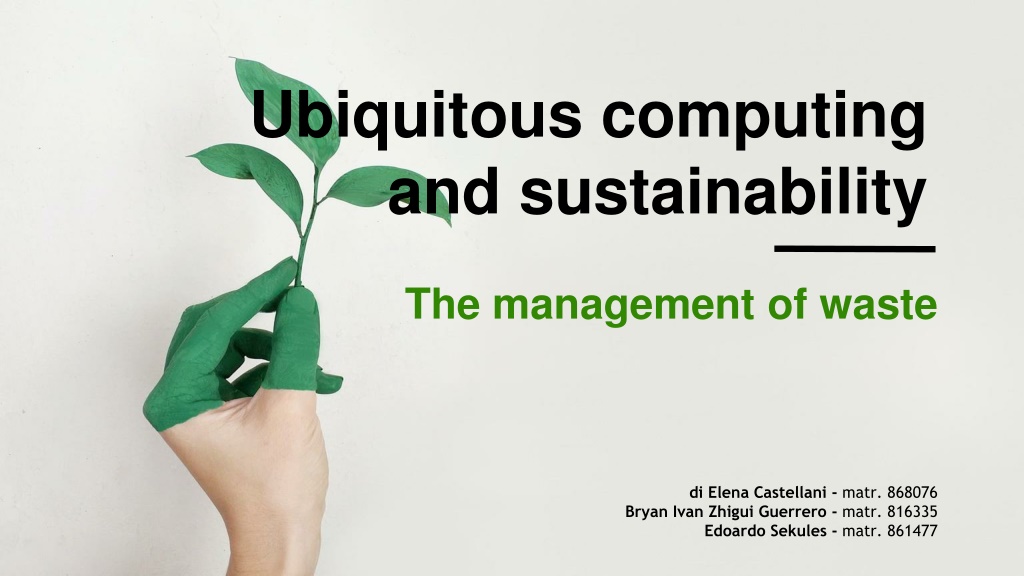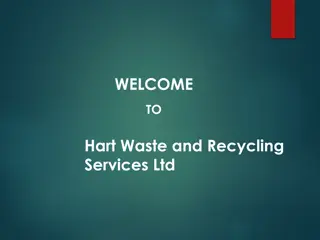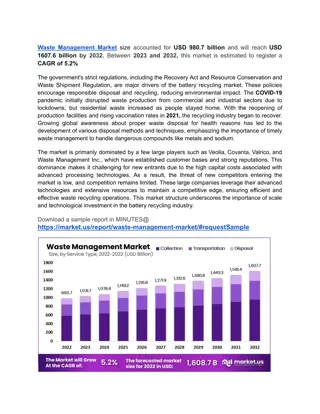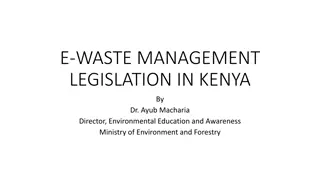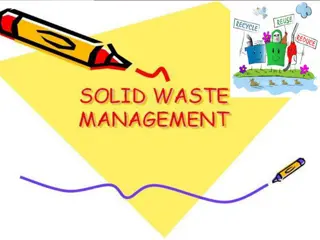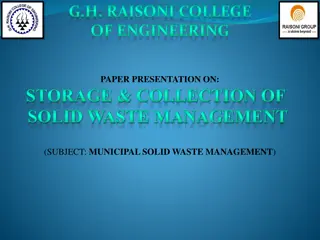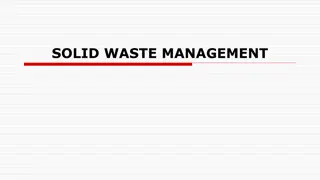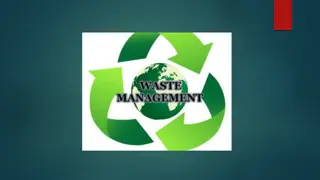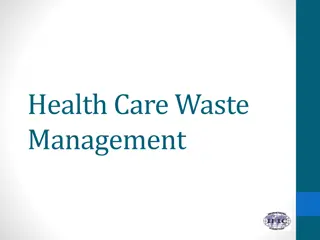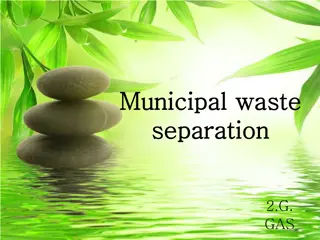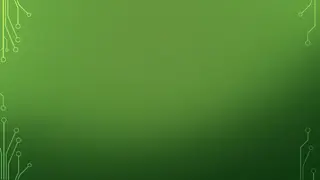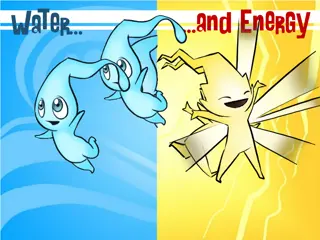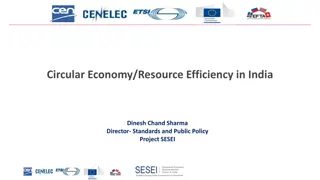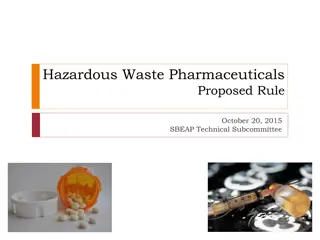Ubiquitous Computing and Sustainability: Waste Management Challenges and Solutions
In the evolving landscape of smart cities and ubiquitous computing, waste management emerges as a critical issue. The growing urban population strains existing waste services and contributes to environmental challenges. This presentation explores innovative technologies and case studies, such as the Re-Wise model for organic waste management, to address these pressing concerns and pave the way for a more sustainable future.
Download Presentation

Please find below an Image/Link to download the presentation.
The content on the website is provided AS IS for your information and personal use only. It may not be sold, licensed, or shared on other websites without obtaining consent from the author. Download presentation by click this link. If you encounter any issues during the download, it is possible that the publisher has removed the file from their server.
E N D
Presentation Transcript
Ubiquitous computing and sustainability The management of waste di Elena Castellani - matr. 868076 Bryan Ivan Zhigui Guerrero - matr. 816335 Edoardo Sekules - matr. 861477
Index Introduction Management Waste Technologies Case study Presentation Model Technology Videos Future Developments Conclusions
Introduction Cities are becoming smarter and the technologies of ubiquitous computing are now spreading in various fields of everyday life. Nowadays, the management of waste is one of the most difficult problem to resolve for many cities.
Management of waste The management of waste is one of the most important and difficult problem which the majority of the city have to face because of: trash removal service; waste disposal service; ecoisland limited capability. Moreover: the expected growth of urban population will increase of energy consumption; the continuous emission of greenhouse will cause changes in the climate system.
Technologies There are new trends and goals pursued to make cities more efficient which concern: wide use of IoT in finding solutions; connection with Big Data: gathered by sensors can be sent to remote servers where it is stored, processed and used for making intelligent decisions for infrastructure and service management.
Case study / Re-Wise Model presentation: The model Re-Wise is an innovative model for the management of organic waste that exploits it as a source renewable energy using existing infrastructure: sewerage purification plant equipped with Anaerobic Digester Released from november 2007 to April 2010
Case study / Re-Wise with OWD Model presentation: 1. OWD + SiQURo 2. Sewarage 3. Purification plant system
Case study / Organic Waste Disposer Technologies This instrument installed at home allows to manage the organic waste and separating from the others without any damage; The organic waste is reduced in small particles thanks to an abrasive action; System SiQURo: Together with OWD allows to quantifies the mass of food treated and send this data at the industries. http://www.ecofast.eu/wp-content/uploads/2017/10/Re-Wise-project.webm
Case study / DeepWaste Model presentation: First mobile app targeted at the problem of erroneous waste disposal; Enables users to be conscious; it also provides an instant and correct waste classification into trash, recycling or compost; Currently available in Beta version for the testing phase.
Case study / DeepWaste Technologies Use of deep learning technologies: simply pointing mobile camera to any piece of waste, the user gets an instantaneous feedback; Combines the recent improvements of convolution neural networks (CNNs) and computational power of modern mobile phones; Use of the D.L. technique Resnet50 implemented into a mobile app by using AppleCoreML by using the hardware of the mobile phone.
Case study / SmartBin (a2a) Model presentation: Manage waste collection in a sustainable way; Avoid to place bins around the cities (SmartBin is currently used is Milano, Brescia, Bergamo and Cremona); No need of power grid; Long-life battery.
Case study / SmartBin (a2a) Technologies SmartBin sends measurements on his filling (empty, half-full or totally full) and blockage (occluded or not occluded); Sensing Technology: two-level plates with electrical capability. Electricity energizes the plates which run measurements thanks to an algorithm. The eventual presence of a stopper is detected by two optical sensors.
Case study / SmartBin (a2a) Technologies In each bin there s a microchip that allows to send data in real time through a wireless network LoRa; LoRa it is integrated into RN2483 Modem, and it covers a radius of 15km - no need of repeaters; Data are collected and sent to a back-end software and managed by a specific team.
Case study / Smarty (Hera) Model presentation: The goal is to promote and stimulate recycling. Punctual and efficient service: Smarty alerts Hera operators in case of fullness or breakdown; More hygienic thanks to the absence of handles and levers.
Case study / Smarty (Hera) Technologies Smarty recognises users thanks to a specific card or smartphone; Data are safe and certifiable and are sent via wireless to the base operations
Case study / RoCycle (MIT) Model presentation: Robotic system which can detect if an object is paper, metal or plastic; The goals are to reduce back-end cost of recycling and incentivize cities and countries to adopt specific recycling programs; 85% accurate at detecting materials; 35% accuracy at detecting the radius of an object and 78% accuracy to recognize soft or hard objects.
Case study / RoCycle (MIT) Technologies Tactile sensors on its fingertips to estimate an object s size and stiffness; Pressure sensors to measure the force needed to grasp the object; Motor-driven hand made of a new material (auxetics) which doesn t shrink when stressed; Fluid-driven approach and dynamic movement.
Case study / Jellyfishbot (IADYS - France) Model presentation: Jellyfishbot is a small marine drone whose mission is to collect floating waste and oil-spills from the water s surface. Commissioned in June 2018 in Cassis (in the south of France), it has been adopted in several countries around the world. The second version of the robot is now under development by IADYS. It is imaged to be totally autonomous and able to detect and capture floating waste - especially plastic measuring between 5 mm and 25 cm in length, and hydrocarbons on the water with the help of environmental and environmental monitoring sensors.
Case study / Jellyfishbot (IADYS - France) Technologies The first version of the small drone is remotely controlled with a joystick and it is battery-run. Its small size (700 x700 x 500 mm) allows it to weave its way everywhere and to easily reach waste carried by the wind and currents into nooks and crannies and saturated zones. To do this, the mini-catamaran made of aluminium and plastic floats is fitted with a net at the stern capable of collecting 80 litres of floating waste and 30 litres of hydrocarbons during each sortie.
Case study / Roboat (MIT, City of Amsterdam) Model presentation: This project imagine a bunch of boats autonomous for the transport of goods and people. The bunch can also cooperate to produce temporary floating infrastructure, like bridges or stages that can be assembled or disassembled in a few hours.
Case study / Roboat (MIT, City of Amsterdam) Technologies With the use of new environmental sensors in addition, the modular robot boats are able to carry out checks in the waters of cities and ensure their cleanliness and supply information on urban health and citizens themselves. The first prototypes of autonomous boats are expected to be tested in Amsterdam in 2017. The project s initial phase will last for five years. The max speed that the self driving boat can reach is 12km/h and the range is about 75 km.
Case study / Roboat (MIT, City of Amsterdam) Advantages: This technology is innovative because makes boats autonomous in the cleaning of the channels and in the movement of people, goods, without also forget the management skills of dynamic infrastructures and sensors environmental.
A reflection The use of the internet of things, sensors and artificial intelligence (drones, robots etc.) represent the future of waste management. The convergence between the aforementioned elements is the only possible solution to major contemporary problems such as overpopulation and climate change. But not only. For companies, for example, the advantage would also be economic because they can increase operational efficiency, cut costs, and enhance customer satisfaction.
Sources Journal of land use, mobility and environment by TeMA Journal of Land Use, Mobility and Environment, 2015 Smart Waste Collection System based on Location Intelligence by Jose M. Gutierreza, Michael Jensenb, Morten Heniusa and Tahir Riazc, 2015 https://www.adambi.com/rmq.html https://www.rfidglobal.it/ 2 gestione rifiutic.indd Re-Wise TheJellyfishBoat Roboat - AMS institute MIT - Massachusetts Institute Of Technology a2a - SmartBin Gruppo Hera - Smarty Ams Institute Deepwaste Solarimpulse
Thanks for your attention
